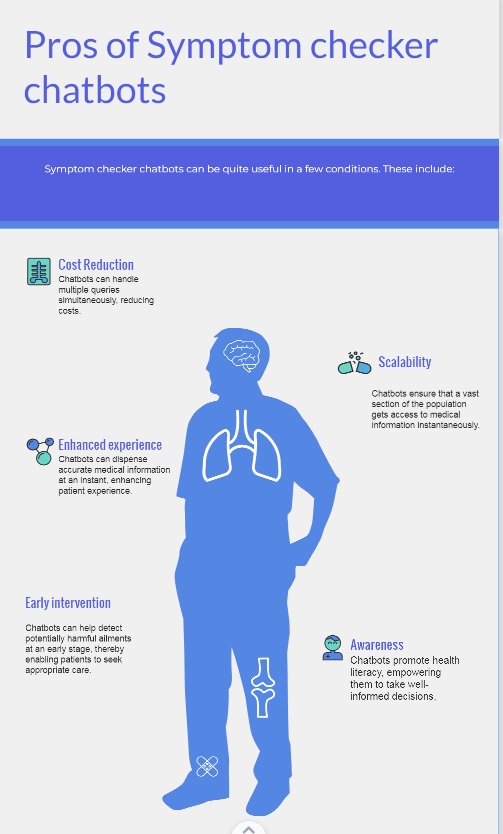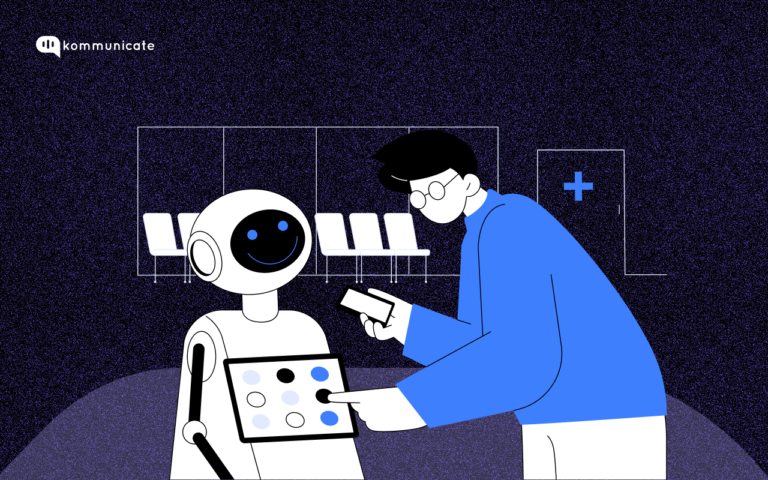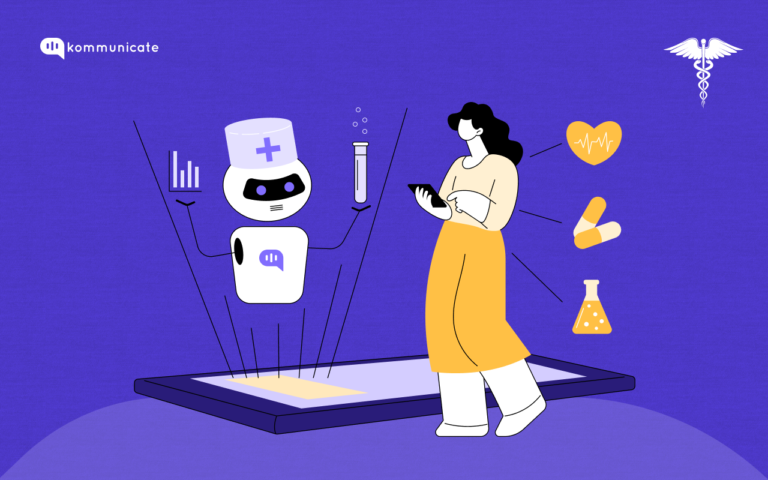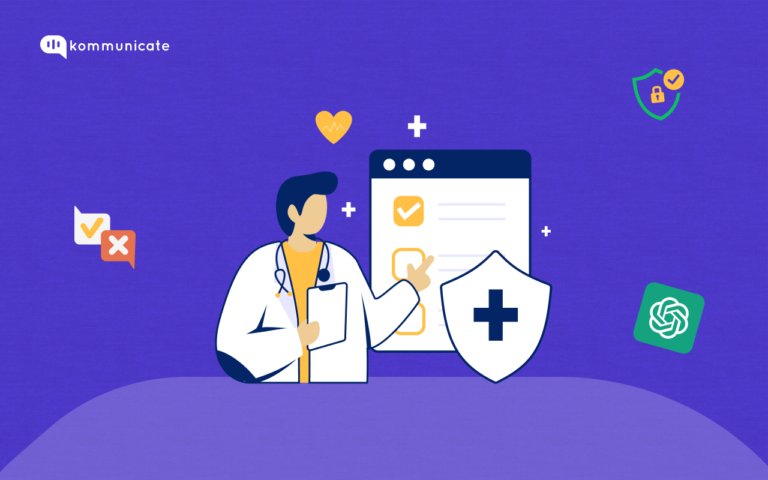Updated on May 19, 2023
Picture this. You have a patient who is sitting in the comfort of their home, getting answers to their most common queries. This without even talking to your hospital support staff.
Your support staff are a happy bunch, since they don’t have to be on the phone or chat all the time responding to repetitive queries.
You also find more and more patients visiting your healthcare facility when you compare the number to previous year. So how did this all happen? Is there a magic pill? And is it actually possible or are these all just hypothetical scenarios?
The one word answer to all these questions: Chatbots.

You see, with chatbots, everything that we have said above comes within our reach. We thus get one step closer to providing the perfect patient experience.
More and more patients are now speaking to bots, because, just like everything else around you, the digital revolution is also taking the healthcare industry by a storm.
According to this report by PSFK, 74% of chatbot users prefer talking to a bot since they provide instant responses.
So the next question is: What are the use cases of chatbots? And specifically, can you use them to assess symptoms of commonly occurring diseases?
In this blog post, we take a look at Symptom checker chatbots, not only listing the pros and cons. We will also explore the impact that they can have on your organization. We will explore how symptom checker chatbots can streamline hospital operations, enhance patient experiences, and unlock hitherto unheard opportunities.
Before we begin, what ARE Symptom assessment chatbots?
What are Symptom assessment chatbots?
In simple words, Symptom assessment chatbots are virtual assistants that have the power of AI behind them. They help individuals diagnose their medical conditions. They do so by answering questions, providing recommendations, and, if the need arises, connecting them to a healthcare professional.
Why use Symptom Checker Chatbots: Pros of Symptom checker chatbots

1. Cost reduction:
Chatbots can handle the queries of several patients simultaneously, thereby reducing the burden on hospital staff. This also reduces the costs associated with hiring and training human resources. For patients, this translates to lesser waiting times.
2. Chatbots are scalable:
One of the key advantages of using chatbots as symptom checkers is their scalability. Chatbots can handle multiple patient queries simultaneously. This ensures that a vast section of the population gets access to accurate medical information, instantaneously.
3. Enhanced patient experience:
Symptom checker bots mean patients get preliminary medical information and guidance in an instant. This enables patients to take a proactive role in managing their health, which leads to an enhanced patient experience.’
4. Early intervention and prevention
Chatbots help identify potential health concerns at an early stage, by providing users with personalized recommendations based on their symptoms. You can thus diagnose many critical diseases at an early stage. This means patients can then approach healthcare institutes with preventive care measures.
5. Awareness tools:
Symptom checker chatbots can educate patients about various health conditions, giving them accurate and reliable healthcare information. By promoting health literacy, chatbots can empower individuals to make well- informed decisions about their overall well – being.
Now that you have seen some of the advantages of Symptom checker chatbots, it is time to look at the other side of the coin. What disadvantages do Symptom checker bots have? Are they a one stop solution for your patients as they are made out to be? Or do they come with their own set of challenges?
Let us now take a look.
Cons of Symptom Checker chatbots
1. Limited Accuracy of Diagnosis:
While a fancy chatbot can dispense instant information, it is not trained to diagnose a medical condition in detail, looking at a patient’s health and gauging their vitals. Doctors acquire these skills after years of practice, and hence, can never be replaced by chatbots. Thus the accuracy of diagnosis by a symptom checker chatbot always remains a concern, and we must tread with caution while using chatbots to assess serious medical conditions.
2. Lack of Empathy:
Symptom checker chatbots may dispense instant information, and can help reduce the workload on healthcare workers, but they can never fully replace them. This is because these chatbots lack the human touch and empathy that a healthcare professional can provide. In many cases, patients may need emotional support, reassurance, and guidance as to how to proceed with their diagnosis. A chatbot may never be able to fill in a human agent’s shoes.
3. Over Reliance on chatbots:
While smartphones are a great way to stay connected, today, we have a situation where a large portion of our population clocks in more screen time than required. Similar is the case with symptom checker chatbots. Patients may become overreliant on these chatbots, using them as a substitute for actual medical advice. Sometimes, this overreliance may backfire, as the chatbots may provide generic information about serious medical conditions, which the patient may not suffer from. This will lead to patient anxiety, a byproduct of this over reliance.
4. Legal concerns:
Legal concerns must be taken into account, especially in the US where patient information is under protection under various compliances such as HIPAA. If, for instance, the symptom checker chatbot dispenses inaccurate information and a patient suffers due to this information, your healthcare facility maybe facing an ugly lawsuit. Thus, Symptom checker chatbots need to be designed and run keeping the legal implications in mind.
5. Can’t handle complex cases
Medical diagnosis still remains a complex procedure, which may involve a team of doctors studying a multitude of factors such as genetics, lifestyle, medical history, etc. of the patient. A symptom checker chatbot is simply not capable of processing such complex medical information, and may sometimes overlook critical information. As the owner of a healthcare institution, you cannot take a risk with the wrong diagnosis of a patient.
Now that we have seen the pros and cons of symptom checker chatbots, let us look at the situations where symptom checker chatbots work best.
When to use Symptom checker chatbots
Here are 5 common scenarios, when using a symptom checker chatbots may make more sense.
1. Initial symptom assessment:
Symptom checker bots are excellent tools for initial triage and symptom assessment. They can help patients with gauging how serious their condition is, and provide basic information about potential causes for their symptoms.
2. Pre-appointment preparation
Chatbots can act as a great tool for gathering information about a patient’s symptoms, current medications and medical history. Using this diverse information, chatbots can prepare comprehensive reports for healthcare providers. Healthcare workers can thus streamline the process of appointment booking, using these reports to make informed decisions.
3. Non-emergency conditions:
When the health condition of a patient is not serious, symptom checker chatbot can act as a great source for dispensing information. Patients seeking advice about their medical conditions, general health tips and advice about common ailments can consult a chatbot. This will take some load off the general healthcare workers, who can use this saved time to focus on critical issues.
4. Support in remote areas
According to this Pew research, rural Americnans live an average of 10.5 miles away from a large hospital, compared to 4.4 miles for an urban American. Thus, not all of the people have equal access to healthcare facilities, which can be a major concern. Symptom checker chatbots can address this issue, by giving individuals preliminary guidance and support. Patients can interact with Symptom checker bots when they don’t have ready access to traditional healthcare facilities.
5. Reduced Waiting times and improved efficiency
Implementing a symptom checker chatbot for your healthcare website means that the patients have already had the time to explain their basic ailment to you. You can use the chatbot to collect basic information such as name, date of birth, address, medical history, etc. Then, you can direct the patients to the appropriate doctors, and use the chatbots to schedule appointments. This will reduce patient waiting times, while improving hospital efficiency.
We have thus seen how symptom checker chatbots can contribute to a healthcare organization’s success. Chatbot builders such as Kommunicate make it easy to build such bots, with pre-built templates and flow designer for easy building.
All we need from your end is a few minutes of your time, and your patients will thank you for it. So what are you waiting for? Get building today!!
At Kommunicate, we envision a world-beating customer support solution to empower the new era of customer support. We would love to have you on board to have a first-hand experience of Kommunicate. You can signup here and start delighting your customers right away.






